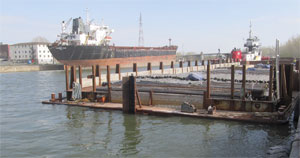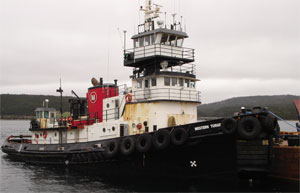A crewman was killed off Newfoundland when tension from a capsizing barge on a tug’s tow cable shattered an auxiliary brake drum that had disabled the tug’s emergency tow release, Canada’s Transportation Safety Board (TSB) has determined.
According to the TSB report, the 115-foot tug Western Tugger had the 295-foot Arctic Lift I, which was carrying a cargo of steel rebar, under tow when the barge capsized on May 10, 2013.
The towing winch was equipped with a main air brake on the steel winch drum and a secondary air brake on the drive shaft. The winch drum had a tendency to slip while towing, even with both brakes applied, so a nut-and-bolt assembly on the secondary brake was used to tighten the brake band and hold the winch drum in place. When the brakes were released, the winch drum would turn freely only if the nut-and-bolt assembly had been loosened.
“The tug had an emergency tow release that was intended to allow an operator located in the wheelhouse to immediately release both air brakes; however, this function was overridden by the nut-and-bolt assembly on the secondary brake,” the TSB report stated.
On the day of the accident, Arctic Lift I developed a large list. The barge had been obscured by fog for several hours and the crew had not been able to observe its condition until 0615. It capsized at 0620. The TSB determined that the capsizing might have been the result of several factors. With minimal freeboard, the aft deck edge of the barge was frequently submerged.
“Shipped water may have created a free surface effect on deck and may have downflooded through hatches that were not adequately sealed, creating a free surface effect within the compartments,” the TSB wrote. “It is also possible that the list occurred because the barge was damaged en route, resulting in water ingress, or because the unsecured cargo had shifted, affecting the barge’s stability.”
With the emergency tow release disabled, it could not be activated from the wheelhouse due to the nut-and-bolt assembly on the secondary brake. The master requested that the deck hand go to the winch room and stand by to loosen the nut.
“Moments later, the forward end of the barge rose out of the water and the barge capsized,” the report said. “The resulting strain on the secondary brake drum caused it to shatter, and parts of it hit and fatally injured the deck hand.”
The welded steel barge Arctic Lift I was built in 1972 in the U.S. and assigned a load line by the American Bureau of Shipping. The vessel was sold to a Canadian owner and began operating in Canada in 1998. The TSB wrote that the current owner purchased and salvaged the barge after a previous occurrence had left it a constructive total loss in 2006.
The TSB said Arctic Lift I was not required to undergo any inspection, demonstrate that it met minimum stability standards, have marked load lines or hold a load line certificate.
 |
|
The barge Arctic Lift I was loaded with steel rebar. |
|
Courtesy TSB |
“In contrast, these are requirements for U.S. barges. Although the Tug and Barge Working Group presented several of these issues to the Canadian Marine Advisory Council in 2006, further requirements for unmanned barges have not yet been developed,” the agency wrote, adding, “As demonstrated in this occurrence, there is a risk that a barge that falls outside of regulations may be overloaded due to the absence of a legitimate load line or may not have watertight hatches, which increases the risk of capsizing. Therefore, if certain types of unmanned barges in Canada continue to operate outside a regulatory framework, there is a risk of these vessels being operated beyond their structural and stability limits.”
The TSB noted that the barge developed a list to starboard due to a combination of factors: water shipped on deck, water ingress, free surface effect, shifting of cargo, and that the barge was loaded with unsecured cargo to an extent that caused the vessel to have minimal freeboard.
The emergency tow release was prevented from operating by a nut-and-bolt assembly.
“The company’s assessments of risks and safe work practices did not identify or mitigate the potential hazard associated with the installation of the nut-and-bolt assembly on the secondary brake and the requirement that it be manually released in an emergency,” the report said.
If an assessment of a vessel’s stability and its loaded condition does not take into account environmental conditions, there is a risk of the vessel being unfit for the voyage.
The TSB said if a tug’s emergency tow release cannot be activated immediately, the vessel and its crew are at increased risk during an emergency. If a vessel operator does not have a safety management system that includes a process for ongoing risk assessments, there is an increased risk that operational hazards will not be identified.
Transport Canada is consulting on the expansion of the Safety Management Regulations. Western Tugger would be required to have a safety management system in accordance with the International Safety Management Code.
The TSB report stated that the vessel operator is repairing the vessel’s towing winch, which will not incorporate a second brake.
Patrick Miller, president of vessel owner Miller Shipping, stated in an email to Professional Mariner that he did not agree 100 percent with the TSB’s findings.
“They were not present during the event and are only giving an opinion based on their findings,” he wrote.

